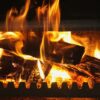Maximizing Heat Retention: Understanding Damper Efficiency in Manassas, VA
In the heart of Manassas, Virginia, when the winter season arrives, residents rely on their fireplaces to provide warmth and comfort. However, an efficient heating system does not solely depend on the type of fuel or the size of the fire. An often overlooked but essential aspect of a heating system is the fireplace damper. Understanding the role of the damper in heat retention and energy efficiency is critical.
A&T Chimney Sweeps fireplace, furnace, dryer vent, gutter cleaning, and repair services in Manassas, VA, frequently encounter clients who underestimate the importance of a well-maintained and efficient damper. This article aims to shed light on the role of the damper in maximizing heat retention and enhancing energy efficiency.
Understanding the Role of the Damper
A fireplace damper is a device installed within the chimney that can be opened or closed at will. When the fireplace is in use, the damper is opened to allow smoke and gases to escape through the chimney. When the fireplace is not in use, the damper is closed to prevent the escape of warm air from inside the house and the entry of cold air from outside.
The efficiency of a damper hinges on its ability to create a tight seal when closed and allow proper ventilation when opened. An inefficient damper can result in significant heat loss and increased energy costs, while a well-functioning damper can enhance heat retention and energy efficiency.
Maximizing Damper Efficiency
There are several ways to maximize damper efficiency and, consequently, heat retention. These include:
1. Regular Inspection and Maintenance: Regular inspection and maintenance can ensure that the damper is functioning optimally. Over time, dampers can become rusted or warped due to the intense heat and corrosive flue gases, impairing their ability to seal properly. Regular maintenance can identify and rectify these issues early.
2. Installing a Top-Sealing Damper: A top-sealing damper is installed at the top of the chimney rather than the traditional location just above the firebox. This type of damper offers superior sealing capabilities, which can significantly improve heat retention.
3. Using a Damper Cap: A damper cap or chimney cap can provide additional sealing and protection for the chimney and the damper. It prevents rain, snow, and debris from entering the chimney and causing damage to the damper.
4. Replacing a Damaged Damper: If a damper is severely damaged or warped, it may be best to replace it. A new damper will ensure a tight seal and improved heat retention.
The Impact of Damper Efficiency on Energy Costs
An efficient damper not only improves heat retention but also reduces energy costs. A poorly functioning damper allows warm air to escape and cold air to infiltrate the home, causing the heating system to work harder to maintain a comfortable temperature. This results in increased energy consumption and higher energy costs. By ensuring the damper is functioning optimally, homeowners can save significantly on their energy bills.
In conclusion, the damper plays a crucial role in maximizing heat retention and enhancing energy efficiency in any home. By understanding its function and ensuring regular maintenance, homeowners can enjoy a warm and comfortable living space while saving on energy costs.
FAQs
1. What is a fireplace damper?
A fireplace damper is a device installed within the chimney that can be opened or closed to control the flow of air and smoke.
2. How does a damper contribute to heat retention?
When the fireplace is not in use, the damper is closed to prevent the escape of warm air from inside the house and the entry of cold air from outside, thereby enhancing heat retention.
3. How can I maximize damper efficiency?
Regular inspection and maintenance can ensure optimal damper efficiency. Installing a top-sealing damper or using a damper cap can also improve heat retention.
4. How does damper efficiency affect energy costs?
A well-functioning damper prevents heat loss, reducing the need for the heating system to work harder. This can lead to significant energy savings.
5. What should I do if my damper is damaged?
If your damper is severely damaged or warped, it may be best to replace it. A new damper will ensure a tight seal and improved heat retention.








